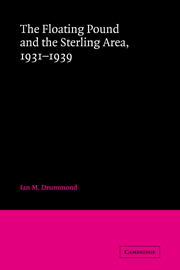Book contents
- Frontmatter
- Contents
- Preface
- 1 Introduction: the sterling area in the 1930s
- 2 Sterling and the rupee
- 3 The Canadian debate over money and exchanges, 1930–1934
- 4 South Africa, sterling, and the gold standard, 1931 and thereafter
- 5 Australia and New Zealand, 1930–1939
- 6 Monetary preparations for the World Economic Conference
- 7 United Kingdom policy at the World Monetary and Economic Conference
- 8 Talking about exchange stabilization, autumn 1933 through June 1936
- 9 The Tripartite Agreement of 1936
- 10 Intergovernmental conversations and the management of sterling, 1936–1939
- 11 Conclusion: the significance of sterling
- Notes
- Index
6 - Monetary preparations for the World Economic Conference
Published online by Cambridge University Press: 07 October 2011
- Frontmatter
- Contents
- Preface
- 1 Introduction: the sterling area in the 1930s
- 2 Sterling and the rupee
- 3 The Canadian debate over money and exchanges, 1930–1934
- 4 South Africa, sterling, and the gold standard, 1931 and thereafter
- 5 Australia and New Zealand, 1930–1939
- 6 Monetary preparations for the World Economic Conference
- 7 United Kingdom policy at the World Monetary and Economic Conference
- 8 Talking about exchange stabilization, autumn 1933 through June 1936
- 9 The Tripartite Agreement of 1936
- 10 Intergovernmental conversations and the management of sterling, 1936–1939
- 11 Conclusion: the significance of sterling
- Notes
- Index
Summary
In June 1933 a World Monetary and Economic Conference was assembled in London. In July the conference collapsed in disorder and failure. At the time the world believed correctly that President Roosevelt had been responsible. Therefore the conference has often been examined in American historical writings, in the memoirs of American participants, and, to a lesser extent, in the memoirs of delegates from France and from other lands. It was widely believed that the conference had broken up over a dispute about exchange rates. France and its Continental associates wanted to fix a relationship between their currencies and the pound and the dollar, both of which were then floating vis-à-vis gold; when the American president refused to tolerate any such linkage, the conference collapsed in disorder and was soon adjourned, its work largely undone.
We shall not try to offer a full account of this remarkable and almost certainly foredoomed effort of world economic diplomacy. We are interested in the conference because of its relationship to the management of sterling and because in the end it provided an unexpected opportunity for a display of Empire monetary solidarity. Our principal purpose, therefore, is to explore the process by which Chamberlain and the Treasury defined and defended their policies with respect to cheap credit and the floating pound. We shall also see how the U.K. authorities tried to define and to propagate schemes for world monetary reconstruction that would help the United Kingdom while avoiding almost all commitments to other powers.
- Type
- Chapter
- Information
- The Floating Pound and the Sterling Area1931–1939, pp. 119 - 161Publisher: Cambridge University PressPrint publication year: 1981

